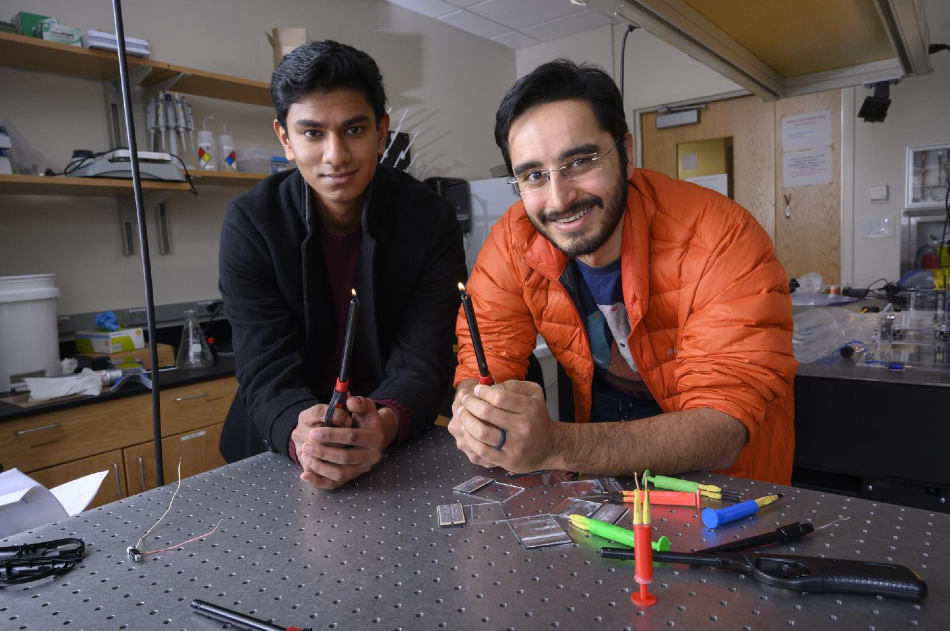Jan 10 2020
A simple method for developing a laboratory device called an electroporator from inexpensive components, such as a piezoelectric crystal taken from a butane lighter, has been created by researchers. The new device applies a jolt of electricity to open cell walls temporarily.
 Georgia Tech undergraduate student Gaurav Byagathvalli and assistant professor Saad Bhamla are shown with examples of butane lighters they used to create the inexpensive ElectroPen—an electroporator device useful in life sciences research. Image Credit: Christopher Moore, Georgia Tech.
Georgia Tech undergraduate student Gaurav Byagathvalli and assistant professor Saad Bhamla are shown with examples of butane lighters they used to create the inexpensive ElectroPen—an electroporator device useful in life sciences research. Image Credit: Christopher Moore, Georgia Tech.
The aim of the researchers is to ensure the availability of the low-cost device to budget-constrained laboratories, high schools, and other organizations whose research might otherwise be restricted by access to traditional lab-grade electroporators. Plans for the device, called the ElectroPen, are being made accessible, together with the files required to create a 3D-printed casing
Our goal with the ElectroPen was to make it possible for high schools, budget-conscious laboratories and even those working in remote locations without access to electricity to perform experiments or processes involving electroporation.
M. Saad Bhamla, Assistant Professor, School of Chemical and Biomolecular Engineering, Georgia Institute of Technology
Bhamla added, “This is another example of looking for ways to bypass economic limitations to advance scientific research by putting this capability into the hands of many more scientists and aspiring scientists.”
The researchers have described the technique for building the ElectroPen in a paper published in the PLOS Biology journal on January 9th, 2020, with support from the National Science Foundation and the National Institutes of Health. The technique has the capability to produce short bursts of over 2,000 V required for an extensive range of laboratory tasks.
One of the main functions of a cell membrane is to act as a protective border that protects the inner mechanisms of a living cell from the outer environment. However, just a brief jolt of electricity can make the membrane to temporarily open and permit foreign molecules to flow inside—a process known as electroporation. For several decades, this process has been used in molecular biology labs for tasks spanning from bacterial detection to genetic engineering.
Although this process is now very common, the high cost of electroporators and their dependence on an electricity source has generally restricted the process to professional or academic labs. In collaboration with undergraduate student Gaurav Byagathvalli, Bhamla endeavored to change the scenario, with support from colleagues Soham Sinha, Yan Zhang, Assistant Professor Mark Styczynski, and Lambert High School teacher Janet Standeven.
“Once we decided to tackle this issue, we began to explore the inner workings of electroporators to understand why they are so bulky and expensive,” stated Byagathvalli.
Since their conception in the early 1980s, electroporators have not had significant changes in design, sparking the question of whether we could achieve the same output at a fraction of the cost. When we identified a lighter that could produce these high voltages through piezoelectricity, we were excited to uncover new mysteries behind this common tool.
Gaurav Byagathvalli, Undergraduate Student, Georgia Institute of Technology
Apart from the piezoelectric lighter crystal that produces current upon applying pressure, aluminum tape, copper-plated wire, and heat-shrinking wire insulator are the other parts in the device. All these parts are held together by a 3D-printed casing designed by the researchers. The casing also acts as the activator of the device. According to the researchers, it would be possible to assemble the device in 15 minutes if all the parts are readily available.
Although the ElectroPen may not be an alternative to a lab-grade electroporator, which has the ability to process a wide range of cell mixtures and costs several thousand dollars, the device still has highly capability to carry out tasks when high volumes are not necessary.
Various different lighter crystals were tested by the researchers to identify ones that generated a consistent voltage with the help of a spring-based mechanism. To gain further insights into the functioning of the lighters, a high-speed camera was used by the researchers at 1,057 frames-per-second to observe their mechanics in slow motion.
One of the fundamental reasons this device works is that the piezoelectric crystal produces a consistently-high voltage, independent of the amount of force applied by the user. Our experiments showed that the hammer in these lighters is able to achieve acceleration of 3,000 Gs, which explains why it is capable of generating such a high burst of voltage.
M. Saad Bhamla, Assistant Professor, School of Chemical and Biomolecular Engineering, Georgia Institute of Technology
The team tested the capabilities of the device by using it on samples of Escherichia coli to add a chemical that renders the bacterial cells fluorescent under unique lights. This illuminates the cell parts and makes them easier to identify. Analogous methods could be employed in remote field operations or in a lab to identify the presence of bacteria or other cells.
The researchers also assessed whether the device was user-friendly by shipping the assembled ElectroPens to students at high schools and other universities.
“The research teams were able to successfully obtain the same fluorescence expression, which I think validates how easily these devices can be disseminated and adopted by students across the globe,” stated Bhamla.
For this purpose, the team has come up with plans for how to assemble the device, together with digital files that a 3D printer can use to develop the casing and actuator. Further steps of the project would be to test a wider range of lighters in the pursuit of consistent voltages over a broader range, the aim of which is to develop ElectroPens of different voltages.
This study was supported by the National Science Foundation (NSF) under grant No. 1817334, the Mindlin Foundation under grant No. MF19-1T1P03, the National Institutes of Health under grant No. R01-EB022592.